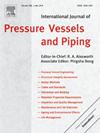P92钢接头热影响区蠕变行为及蠕变空洞组织演变
IF 3
2区 工程技术
Q2 ENGINEERING, MECHANICAL
International Journal of Pressure Vessels and Piping
Pub Date : 2025-03-15
DOI:10.1016/j.ijpvp.2025.105512
引用次数: 0
摘要
P92钢接头的IV型断裂以微腔聚集导致蠕变开裂为特征,对超超临界电厂P92钢管道的运行安全构成重大风险。因此,研究接头热影响区蠕变空洞的演变,为潜在的开裂风险提供早期预警是必要的。本研究对两种不同的P92钢接头的硬度、显微组织和电子背散射衍射(EBSD)图像进行了表征,其中P92钢接头表现为IV型断裂,而P92钢接头则没有断裂。基于对均质材料蠕变损伤机制的理解,结合P92钢管道接头失效的实际观察,我们利用基于微观力学的模型阐明了这些非均质材料热影响区内蠕变空洞的微观组织演变。我们的研究结果表明,受不同蠕变特性的影响,蠕变空洞的形核在接头的不同区域有所不同。此外,这些空腔的生长受静水应力和应力三轴性因素的调节,而空腔的聚并主要受轴向应力的控制。为了减轻IV型断裂,提高热影响区的抗蠕变能力和降低轴向应力水平至关重要。本文章由计算机程序翻译,如有差异,请以英文原文为准。
Creep behavior and microstructure evolution of creep cavities in the heat-affected zone of P92 steel joints
The Type IV fracture of P92 steel joints is characterized by the aggregation of micro-cavities leading to creep cracking, which presents a significant risk to the operational safety of P92 steel pipelines in ultra-supercritical plants. Consequently, it is essential to examine the evolution of creep cavities in the heat-affected zone of joints to provide early warning of potential cracking risks. This study characterized the hardness, microstructures, and electron backscatter diffraction (EBSD) images for two different P92 steel joints exhibiting Type IV fracture, as well as for a P92 steel joint without fracture. By building upon the understanding of creep damage mechanisms in homogeneous materials and integrating practical observations from P92 steel pipeline joint failures, we elucidated the microstructural evolution of creep cavities within the heat-affected zone of these heterogeneous materials using a micromechanics-based model. Our findings indicate that the nucleation of creep cavities varies across different regions of the joint, influenced by their distinct creep characteristics. Additionally, the growth of these cavities is regulated by the hydrostatic stress and stress triaxiality factor, while cavity coalescence is primarily governed by axial stress. To mitigate Type IV fracture, it is crucial to enhance creep resistance in the heat-affected zone and minimize axial stress levels.
求助全文
通过发布文献求助,成功后即可免费获取论文全文。
去求助
来源期刊
CiteScore
5.30
自引率
13.30%
发文量
208
审稿时长
17 months
期刊介绍:
Pressure vessel engineering technology is of importance in many branches of industry. This journal publishes the latest research results and related information on all its associated aspects, with particular emphasis on the structural integrity assessment, maintenance and life extension of pressurised process engineering plants.
The anticipated coverage of the International Journal of Pressure Vessels and Piping ranges from simple mass-produced pressure vessels to large custom-built vessels and tanks. Pressure vessels technology is a developing field, and contributions on the following topics will therefore be welcome:
• Pressure vessel engineering
• Structural integrity assessment
• Design methods
• Codes and standards
• Fabrication and welding
• Materials properties requirements
• Inspection and quality management
• Maintenance and life extension
• Ageing and environmental effects
• Life management
Of particular importance are papers covering aspects of significant practical application which could lead to major improvements in economy, reliability and useful life. While most accepted papers represent the results of original applied research, critical reviews of topical interest by world-leading experts will also appear from time to time.
International Journal of Pressure Vessels and Piping is indispensable reading for engineering professionals involved in the energy, petrochemicals, process plant, transport, aerospace and related industries; for manufacturers of pressure vessels and ancillary equipment; and for academics pursuing research in these areas.

 求助内容:
求助内容: 应助结果提醒方式:
应助结果提醒方式:


